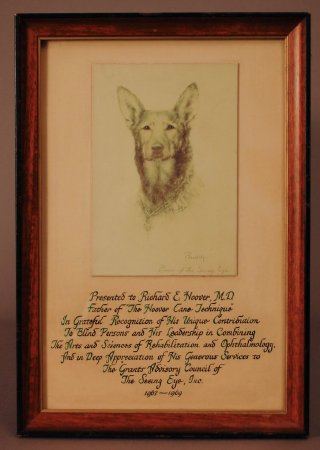Object ID:
2007.33.100
Title:
Presentation Photo, Buddy: Pioneer of the Seeing Eye
Description:
Framed print of "Buddy/Pioneer of the Seeing Eye," a German Shepherd with chain collar; mounted to matboard, hand inked caligraphy below in green and black, "Presented to Richard E. Hoover, M.D./Father of "The Hoover Cane Technique"/In Grateful Recognition of His Unique Contribution/To Blind Persons and His Leadership in Combining/The Arts and Sciences of Rehabilitation and Ophthalmology,/And in Deep Appreciation of His Generous Services to/The Grants Advisory Council of/The Seeing Eye, Inc./1967-1969"; frame has gold enamel on inner molding and black enamel on sides, with reddish finish on front.
Dimensions:
H-13.125 W-9.125 D-0.875 inches
Date:
1969
Provenance:
Part of papers of Dr. Richard Hoover transferred to the AER Bledsoe Archives at the Maryland School for the Blind in the 1980s. "Buddy" became the first American guide dog when he arrived with his owner, Morris Frank, in New York in 1928. Frank and the dog's breeder , Dorothy Eustis, eventually founded the nation's first dog guide program, The Seeing Eye. Hoover has been referred to as the "Father of the Lightweight Long Cane Technique." In 1944 as an army sergeant, he was assigned to the center for the treatment of blinded soldiers Valley Forge Army Hospital. There he developed a successful cane technique, replacing the traditional short wooden cane with a lightweight long cane cut to a prescription length and using the technique of arcing the cane from side to side with the tip touching the ground in front of the trailing foot. Following the war, Richard Hoover entered medical school and became a distinguished ophthalmologist.
Credit Line:
Gift of Association for Education and Rehabilitation of the Blind and Visually Impaired
